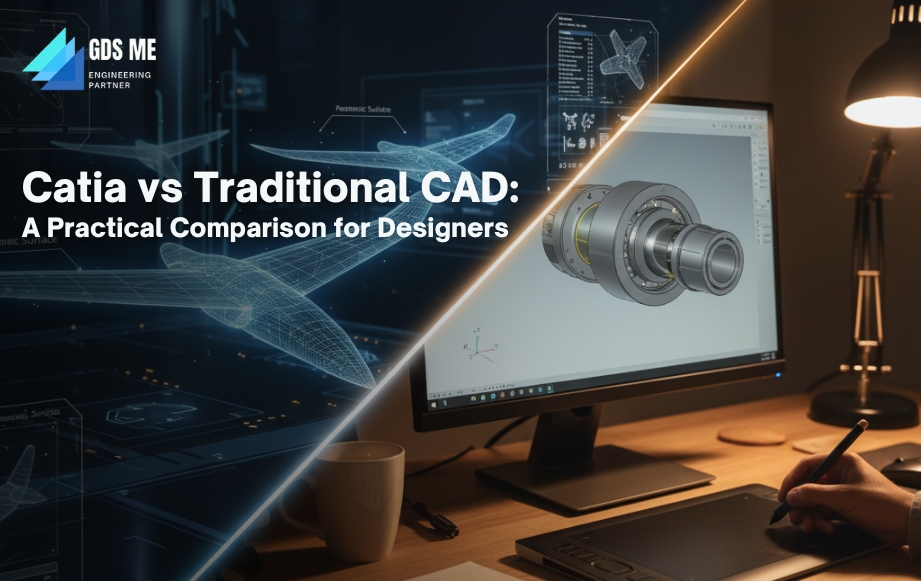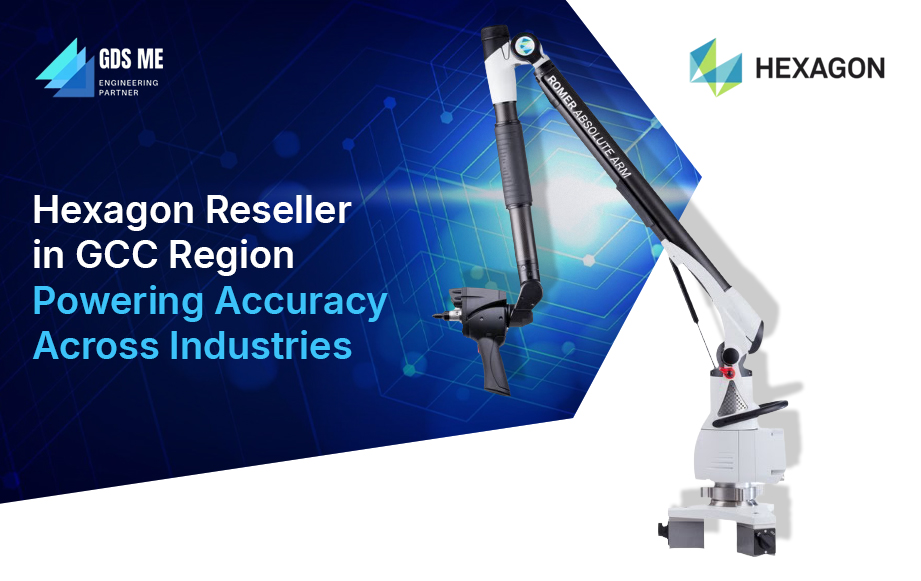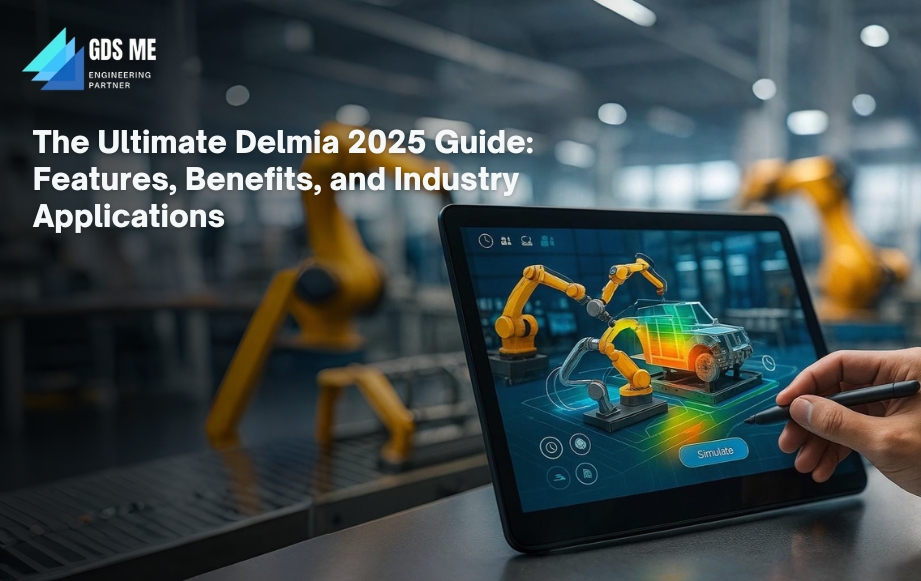From new city skylines to massive industrial plants, the Gulf Cooperation Council (GCC) countries — Saudi Arabia, the UAE, Qatar, Oman, Kuwait, and Bahrain — are turning into some of the world’s most dynamic project zones. Behind that design are teams working quietly with their trusted CAD tools. Some are deep into AutoCAD, sketching layouts and sections. Advanced platforms like CATIA are quite helpful while building complex 3D models or digital twins.
One focuses on simplicity, the other on precision and innovation. But how do these tools actually fit into the fast-paced work culture of the GCC?
That’s where Generative Design Solutions Middle East (GDME) steps in. GDME is an authorized Dassault Systèmes partner that helps companies across the GCC get the most out of CATIA and the 3DEXPERIENCE platform. From onboarding software to training design teams, they make sure technology doesn’t stay locked in a manual — it’s put to real use on-site, in offices, and on production floors.
The blog is not about proving which one is better. It’s about seeing how both worlds — the traditional and the advanced — work together to build the region’s future.
Popular CAD Tools
AutoCAD
How do architects create floor plans so quickly? AutoCAD is one of the tools that helps engineers and architects draft accurate 2D and simple 3D layouts.
SolidWorks
Do the machine parts fit together perfectly? Can you check it during the design phase? SolidWorks lets designers model and simulate assemblies virtually.
SketchUp
See your room or building idea in 3D instantly with SketchUp. This tool makes creating and adjusting visual models fast and easy.
Fusion 360
Can teams in different cities work on the same design in real time? Fusion 360 allows online collaboration for designing, testing, and tweaking products.
Revit
How do large building teams avoid mistakes and stay coordinated? Revit keeps architects, engineers, and contractors synced on one model.
And many More…
For a full comparison of CAD tools, see here
What is CATIA?
CATIA (Computer-Aided Three-dimensional Interactive Application) is the software engineers turn to when a design is too complex for ordinary tools. A car designer working on a new sports car uses CATIA to sculpt every curve, test how doors swing, and see if the engine fits perfectly — all digitally. It’s like holding the entire car in your computer before it exists in real life. It avoids the need for building multiple physical prototypes.
What sets CATIA apart is its ability to handle multiple stages of product development under one roof. You can work on mechanical assemblies, electrical wiring, fluid systems, electronics, and even highly complex surface designs — all in the same model. Its cloud-based collaboration enables a designer in Paris and a manufacturer in Dubai to work on the same project simultaneously.
Credit – https://www.youtube.com/@goengineer
Key Features of CATIA
- Advanced 3D modeling and surface design
- Digital mock-ups and product simulations
- Collaborative design for large teams
- Supports complex assembly and system engineering
- Integrated with manufacturing and engineering tools
CATIA serves as the primary design software for multiple industrial sectors.
Industries that Use CATIA
- The aerospace and defense sectors for designing aircraft and spacecraft systems.
- The automotive sector
- Industrial machinery manufacturers
- Consumer products and electronic equipment manufacturing companies and many more.
What is AutoCAD?
AutoCAD functions as a leading CAD software system that professionals use worldwide. The software functions as a fundamental design tool for architects, engineers, and construction specialists who require 2D drafting capabilities and basic 3D modeling functions. The software provides users with a straightforward interface for creating drawings that can be displayed either on paper or digital screens.
Credit – https://www.youtube.com/@E3D_Autocad
Key Features of AutoCAD
- 2D drafting and annotation
- 3D modeling and visualization
- Extensive libraries and templates
- Layer management for organized designs
- Collaboration through cloud and shared files
Industries Using AutoCAD
- Architecture and construction
- Civil and structural engineering
- Interior design and space planning
- Electrical and mechanical engineering
CATIA vs AutoCAD: A Real-World Comparison
Here is a table that provides you with a quick overview of CATIA and AutoCAD for a perfect comparison.
| Feature | CATIA | AutoCAD |
|---|---|---|
| Purpose | CATIA is used to build products from the ground up — from the first sketch to a ready-to-produce model. | AutoCAD mainly helps in drafting detailed 2D drawings and quick 3D concepts. |
| Design Approach | Great for shaping detailed parts and simulating how everything fits and moves. | Known for neat, accurate layouts — perfect for construction or layout drawings. |
| Who Uses It | Engineers in automotive, aerospace, and industrial design rely on it. | Common among architects, interior designers, and civil engineers. |
| 3D Tools | Strong in 3D modeling — handles surfaces, solids, and assemblies smoothly. | Basic 3D options — ideal when you don’t need heavy modeling. |
| Testing Features | Lets you test how a product performs under real-world stress or motion. | Needs add-ons or other software for that kind of analysis. |
| Teamwork | Teams can work on the same model and share real-time updates. | Sharing is simpler but usually limited to sending files back and forth. |
| Project Control | Works well with PLM systems, keeping every version organized. | Doesn’t have built-in project control — users handle it manually. |
| Flexibility | Less customizable but very stable for big company setups. | Can be shaped your way with scripts, plug-ins, or add-ons. |
| Learning Curve | Takes patience and proper training, but once mastered, it’s powerful. | Easier to learn — that’s why it’s often the first CAD tool for beginners. |
| File Formats | Opens and saves files like CATPart, IGES, and STEP. | Works with DWG, DXF, and other common file types. |
| System Power | Needs a strong workstation with good graphics support. | Runs smoothly even on average computers. |
| Cost | Usually expensive and used by larger companies. | More budget-friendly, with options for individuals or smaller firms. |
| Learning Help | Training is mostly through certified courses or workshops. | Tons of tutorials and community help available online. |
| Best Fit | Ideal for full-scale product design and virtual testing. | Perfect for plans, layouts, and everyday drafting work. |
GDS: Generative Design Solutions Middle East (GDSME)
Who are we?
- GDSME is a Dubai-based engineering & IT solutions company. We serve the UAE, Saudi Arabia, Kuwait, Qatar and other GCC countries.
- We are an authorized partner for Dassault Systèmes, which means we sell the best versions of CATIA (both CATIA V5 and 3DEXPERIENCE CATIA)
Geographical presence & support
- Offices/operations in the UAE and Saudi Arabia explicitly.
- We offer “CATIA for the classroom,” meaning academic licensing and training, too.
Why do many consider us the best reseller in the GCC?
Here are reasons that make GDSME a top choice:
| Criteria | GDSME’s Strengths |
|---|---|
| Regional knowledge | We know how things work in GCC (law, language, business culture). |
| Full package | Not just software — also training, support, consulting. |
| Certified staff | Dassault’s own certification and partnership backing. |
| Broad portfolio | We handle CATIA V5, 3DEXPERIENCE, simulation tools, PLM etc. |
| Education link | Good deals & support for academic institutions. |
Latest versions of CATIA
The latest versions of CATIA are 3DEXPERIENCE CATIA and CATIA V5, developed by Dassault Systèmes.
The latest release of 3DEXPERIENCE CATIA – R2025x (released in November 2024) is targeted at more streamlined workflows, improved collaboration, and enhanced design visualization. The users can now have a new level of improved surface modeling capabilities, accelerated rendering, and simplified interface for advanced product design. The platform also enhances its cloud-based roles, becoming easier for teams that are located remotely to work in complete harmony with each other.
Source: 3dswym.3dexperience.3ds.com
For those still using the classic desktop edition, CATIA V5 continues to receive updates. The latest version here is V5-6R2025 (also referred to as V5R35). While it doesn’t have the cloud-based features of 3DEXPERIENCE, it remains widely used across industries because of its stability, backward compatibility, and reliability for mechanical and industrial design projects.
Source: type3-caa.com
What makes us strong? Why Choose GDS?
- We don’t just sell software—we do implementation, training, technical support, and PLM (Product Lifecycle Management) consulting.
- We are authorized Dassault Systèmes Partners, so engineers at GDSME can assist you comprehensively.
- Our experience spans industries like manufacturing, construction, and electronics. We understand local needs (e.g., regulatory, language, culture) in the GCC.
- We handle CATIA V5, 3DEXPERIENCE, simulation tools, PLM, etc.
In the GCC, designing the future isn’t about picking just one CAD tool. It’s about picking the right one for the job. AutoCAD? Perfect for neat floor plans and simple layouts. CATIA? That’s where the magic happens. Complex 3D models, simulations, even projects that go beyond regular drafting—you can do it all.
And here’s the thing—GDS Middle East (GDSME) makes it work. They don’t just sell software. Skyscrapers, factories, vehicles—when the right tools meet real expertise, everything runs smoother.
FAQs
A. Not really. It depends on what you’re trying to do. AutoCAD is quick and simple for 2D work. CATIA is better for complex designs.
A. Yes. Many teams start in AutoCAD and then switch to CATIA for the tricky parts.
A. Yep. Parts, wiring, even fluid systems—all in one model. Makes seeing how everything fits together a lot easier.
A. The 3DEXPERIENCE cloud allows designers in different locations to work on the same project simultaneously without any confusion.
Reach out to GDS today!
See how your projects can move faster, smoother, and smarter across the GCC







